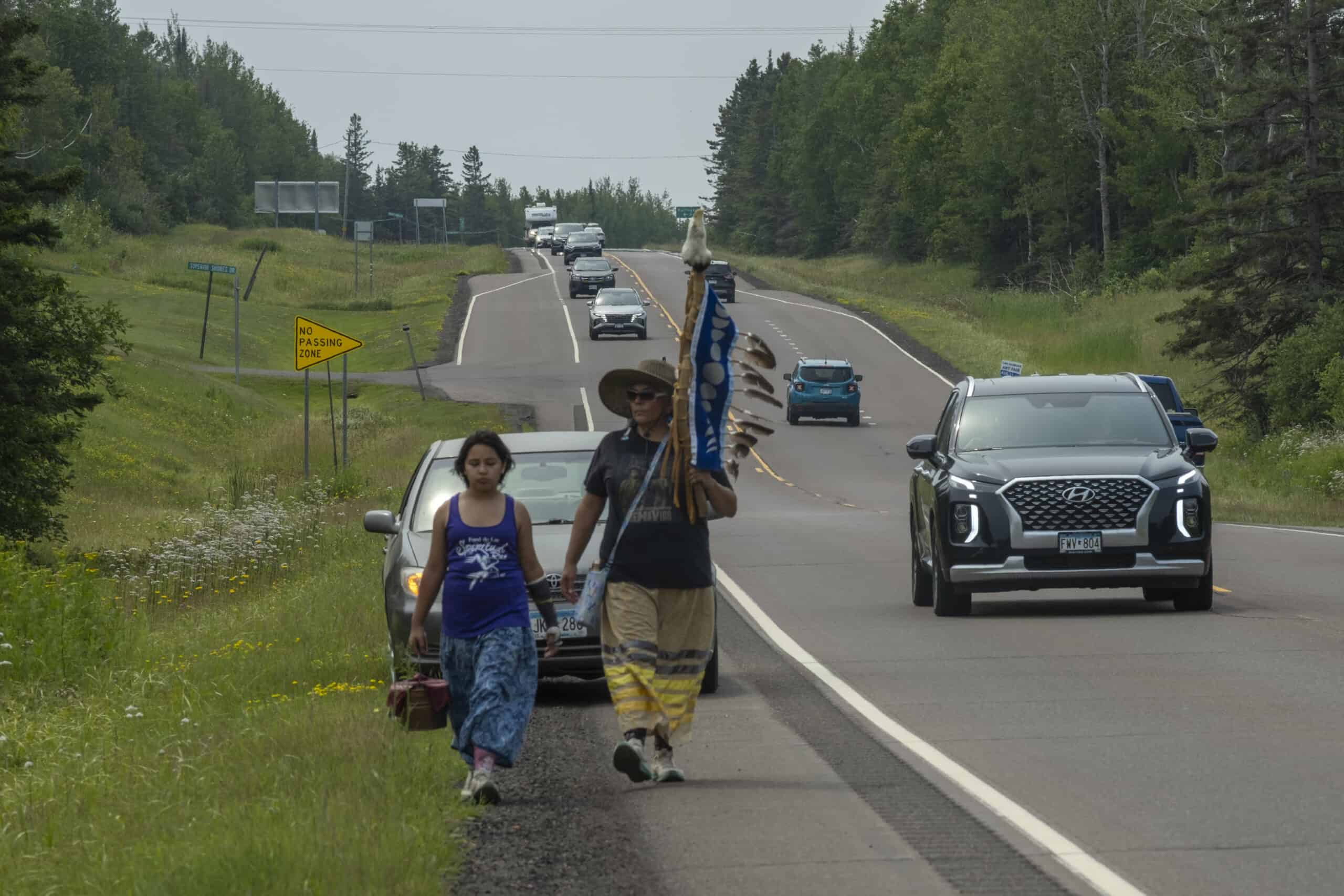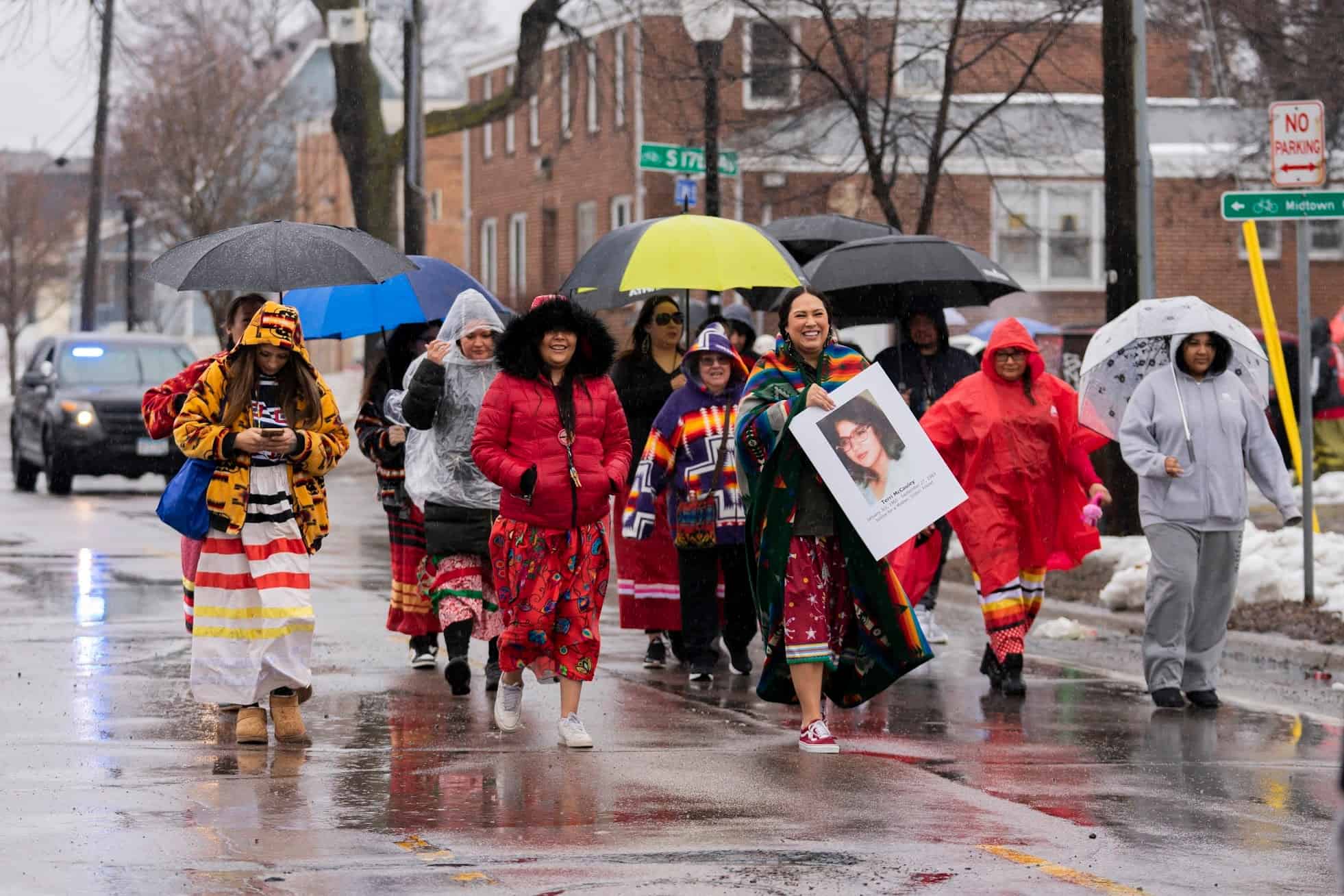Missing And Murdered Indigenous Women and Relatives
Too many families and communities have been hurt by not knowing what happens to their sisters, mothers, aunties, and other people they know and love.
People disappear in ways that leave communities grappling with the unknown. Some people are missing for years without people even knowing to look for them. When people are found, many people experience the heartbreaking pain that comes with losing a relative in a violent way. Families are left to fight for justice against systems that often are ill-prepared to handle cases like this or deprioritize and under-investigate cases of missing Indigenous people.


Things need to change. No more missing and murdered relatives!
Thankfully, more people are recognizing the extent and impact of MMIWR across the U.S. and Canada. With more eyes and more attention, we are slowly beginning to see resources and research around supporting families and understanding the complexity and wide-spreading nature of MMIWR. If you know of any additional resources, please email it to [email protected] and we will add it to this list!
* A quick note on language: while many of the resources on this list use the term missing and murdered Indigenous women (MMIW), MIWSAC chooses the term MMIWR to acknowledge that our Two Spirit, LGBTQI, non-binary relatives, as well as Native men and boys, who are also targeted and invisibilized.

Community Search and Information Groups
Sahnish Scouts of
North Dakota
Sahnish Scouts was founded in 2013 by Lissa Yellow Bird, along with family and friends, to respond to the disappearances of people in the Bakken oilfields in North Dakota. Since then, more than a hundred families have sought our support in cases where their loved ones are unaccounted for. We offer a safe space, free of shame and blame, for relatives of the missing to share information. We not only publicize missing persons, we search for them. We assist law enforcement or fill in where they are absent. We believe that everyone deserves to be looked for.
Gitchigumi Scouts
Frontlines effort led by Indigenous women to protect Native territory from the destruction and extraction associated with Calgary-based energy giant Enbridge’s 1,000-mile Line 3 tar sands pipeline project through community patrols related to fossil fuel infrastructures and monitoring the impacts of extractive industries on Native communities, particularly on Indigenous women.
What To Do If Someone Goes Missing
This information was adapted from work by Lissa Yellowbird-Chase, Sahnish Scout of North Dakota. For more information, email [email protected]
This information is meant to help families and communities find and protect people they care about. This is not everything that may need to be done and is simply meant to be a starting point. You are not alone. Connect with organizations and people for help.
• Many family members do not want to call law enforcement because they think they are “overreacting.”
• They don’t want to cause trouble for a family member because they may be doing something illegal.
• Law enforcement may not be “responsive” to calls for help.
• Get the Report Number
• It is not normal behavior to be gone for long.
• Learn local laws
• Document EVERYTHING. Important tools include a journal and digital audio recording device
• Protect your scene/evidence
• Set aside items for canine searches/DO NOT TOUCH to retain scent
• Identifying information sources
• Use social media
• Create a poster. Use clear pictures including both face and body, with known location(s), contact information, medical information, including identifiable birthmarks, tattoos, etc.
Planning should include who will help to:
• Document everything
• Make calls
• Monitor social media
• Put up posters
• Search immediate & frequented areas
• Who is your contact person/s
• Take photos of different possible locations ASAP for future reference
• The most crucial information comes from tracking your loved ones last known location and up to 72 hours before their disappearance.
• Answer the who, what, where, why, and when?
• If your search passes the 48-72 hour mark, days & weeks start to blend together and you’ll have to rely on your timeline.
• Most cell phone companies begin to purge info within 72 hours
• Additional apps on the phone will require a separate letter directly to the App provider (texting apps, Facebook, Snapchat, Instagram, etc)
• In many cases the concern for “preservation” happens too late
• Bank records
• Social service ~ EBT cards
• Child support
• Social Security
• Tribal/BIA accounts
• Digital footprints
- People wanting financial gain:
- Self-Care:
- If fundraising, be careful with who acts as financial agent
- It can be easy to exhaust yourself under these circumstances.
- Document EVERYTHING People taking advantage of vulnerable families
- BREATHE!
- For example, providing “services” for a cost
- Remember to sleep, nap, rest as you are able
- Most legitimate helpers do not charge
- Drink lots of water
- Eat nourishing food
- Seek out spiritual help.
- Remember spiritual help is not always human.
1. Make the Call!
• Many family members do not want to call law enforcement because they think they are “overreacting.”
• They don’t want to cause trouble for a family member because they may be doing something illegal.
• Law enforcement may not be “responsive” to calls for help.
• Get the Report Number
• It is not normal behavior to be gone for long.
2. Beginning Your Search
• Learn local laws
• Document EVERYTHING. Important tools include a journal and digital audio recording device
• Protect your scene/evidence
• Set aside items for canine searches/DO NOT TOUCH to retain scent
• Identifying information sources
• Use social media
• Create a poster. Use clear pictures including both face and body, with known location(s), contact information, medical information, including identifiable birthmarks, tattoos, etc.
3. Planning Help
Planning should include who will help to:
• Document everything
• Make calls
• Monitor social media
• Put up posters
• Search immediate & frequented areas
• Who is your contact person/s
• Take photos of different possible locations ASAP for future reference
4. Start a Timeline
• The most crucial information comes from tracking your loved ones last known location and up to 72 hours before their disappearance.
• Answer the who, what, where, why, and when?
• If your search passes the 48-72 hour mark, days & weeks start to blend together and you’ll have to rely on your timeline.
5. Ask Your Law Enforcement Agent to File a “Letter of Preservation” to Cell Phone Company
• Most cell phone companies begin to purge info within 72 hours
• Additional apps on the phone will require a separate letter directly to the App provider (texting apps, Facebook, Snapchat, Instagram, etc)
• In many cases the concern for “preservation” happens too late
6. Additional Sources to Track
• Bank records
• Social service ~ EBT cards
• Child support
• Social Security
• Tribal/BIA accounts
• Digital footprints
7. Be Watchful for Potential Fraudsters or Opportunists
People wanting financial gain
• If fundraising, be careful with who acts as financial agent
• Document EVERYTHING
People taking advantage of vulnerable families
• For example, providing “services” for a cost
• Most legitimate helpers do not charge
Self-Care:
• It can be easy to exhaust yourself under these circumstances.
• BREATHE!
• Remember to sleep, nap, rest as you are able
• Drink lots of water
• Eat nourishing food
• Seek out spiritual help.
Remember spiritual help is not always human.

